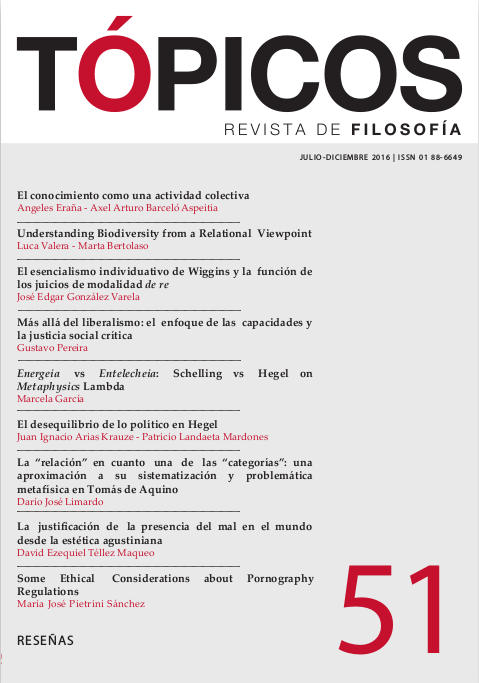Pubblicato 2016-07-01
Come citare
Downloads
Altmetrics
Citas
Abstract
The aim of this paper is to propose four ethical conditions so as to regulate pornography in a liberal democratic state: the first two are related with the production of the pornographic material; the third with the content of the material; and the fourth with its social repercussions. In order to do so, a definition of pornography is firstly presented, under the scopes of the radical and liberal feminists. Secondly, a normative framework is developed to determine when the pornographic material is ethically permissible, and when it is not. Finally, a recommendation is provided in relation to what the state should do in each case, and a distinction is made between three fields: (i) the conditions in which pornography is produced, (ii) the content it represents or depicts, and (iii) its social consequences. The conclusion to this paper is that the state should not censure all pornographic materials, as radical feminists insist upon, but only ban and punish those which do not meet the ethical conditions advised.
Riferimenti bibliografici
- About Project Unbreakable - Project Unbreakable. (2013). Retrieved March 22, 2016, from http://project-unbreakable.org/about/
- Almodovar, N. J. (2006). Porn Stars, Radical Feminists, Cops, and Outlaw Whores: The Battle Between Feminist Theory and Reality, Free Speech, and Free Spirits. In Prostitution and Pornography, Philosophical Debate about the Sex Industry. J. Spector (Ed.) (149-174). Stanford, CA: Stanford University Press.
- Bourdieu P. & Wacquant L. J. D. (1996). An Invitation to reflexive sociology. Chicago: The University of Chicago Press.
- Convention on the Elimination of all form of Discrimination Against Women. (CEDAW). (1992). General recommendations made by the Committee on the Elimination of Discrimination against Women. Retrieved May 27, 2016, from http://www.un.org/womenwatch/daw/cedaw/recommendations/recomm.htm#recom19 General Recommendation No. 19 (llth session, 1992)
- Dworkin, A. (1981). Pornography: Men possessing women. New York: Perigee Books.
- Dworkin, R. (1993). Women and Pornography. New York Review of Books, XL (17).
- Dyzenhaus, D. (1992). John Stuart Mill and the Harm of Pornography. Ethics, 102(3), 534-551.
- Easton, S. M. (1994). The problem of pornography: Regulation and the right to free speech. London: Routledge.
- Eaton, A. (2007). A Sensible Anti-Porn Feminism. Ethics, 117(4), 674-715. Feinberg, J. (1985). O ense to Others: The Moral Limits of the Criminal Law. New York: Oxford University Press.
- Fish, S. E. (1994). There is no Such Thing as Free Speech... And it’s a good thing too. New York: Oxford University Press.
- Goodman, N. (1976). Languages of Art: An approach to a Theory of Symbols. 2nd edition, Indianapolis: Hackett Publishing Company.
- Langton, R. (1993). Speech Acts and Unspeakable Acts. Philosophy and Public Affairs, 22(4), 293-330.
- ____ (1990). Whose Right? Ronald Dworkin, Women, and Pornographers. Philosophy and Public A airs, 19(4), 311-359.
- Longino, H. E. (1980). Pornography, Oppression and Freedom: A Closer Look. Take Back the Night: Women on Pornography. L. Lederer (Ed.) (40-54). New York: Morrow.
- McElroy, W. (1995). XXX: A Woman’s Right to Pornography. New York: St. Martin’s Press.
- Mackinnon, C. (1993). Only Words. Cambridge, MA: Harvard University Press.
- ____ (1989). Towards a Feminist Theory of State. Cambridge, MA: Harvard University Press
- ____ (1987). Feminist Unmodi ed. Cambridge, MA: Harvard University Press.
- ____ (1985). Pornography, Civil Rights and Speech. In Pornography: Women, Violence and Civil Liberties. C. I in (Ed.) (456-551). New York: Oxford University Press.
- Mill, J. S. (1975). On the liberty. Three Essays. New York: Oxford University Press.
- Nussbaum, M. (1999). Rage and Reason. Sex and Social Justice (239-252). New York: Oxford University Press.
- Preciado, B. (2008). Testo Yonque. Espasa: Madrid.
- Schwarzenbach, S. (2006). Contractarians and Feminists Debate Prostitution. In Prostitution and Pornography, Philosophical Debate about the Sex Industry. J. Spector (Ed.) (209-239). Stanford, CA: Stanford University Press.
- Scoccia, D. (1996). Can Liberals Support a Ban on Violent Pornography?Ethics, 106(4), 776–799.
- Strossen, N. (1995). Defending Pornography: Free Speech, Sex and the Fight for Women’s Rights. New York: Scribner. United Nations. The Universal Declaration of Human Rights (UDHR). Retrieved May 27, 2016, from http://www.un.org/en/universal- declaration-human-rights/index.html
- United Nations. The Universal Declaration of Human Rights (UDHR). Retrieved May 27, 2016, from http://www.un.org/en/universal-declaration-human-rights/index.html
- United Nations General Assembly (UNGA). (1993). Declaration on the Elimination of Violence against Women. Res 48/104, 48. (No.49) at 217, U.N.Doc.A7-48/49. Retrieved May 27, 2016, from http://www1.umn.edu/humanrts/instree/e4devw.htm
- West, C. (2006). The Free Speech Argument against Pornography. Canadian Journal of Philosophy, 33(3), 391-422.







